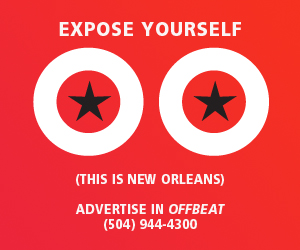[UPDATED] Mardi Gras Indian costumes are now officially works of art. Fans of the New Orleans Indian tradition have long held this view, but the US Copyright Office recognized the suit of Creole Wild West’s Chief Howard Miller as sculpture/3D artwork effective April 13, 2010. So far, 10 Mardi Gras Indians have applied to copyright protect their suits, which would mean among other things that photographers would have to pay them to sell shots of their costumes in some circumstances.
According to lawyer Ashlye Keaton, the designation is validation of what Mardi Gras Indians do. “It’s an empowerment tool,” Keaton says. “The fact that the suits are subject to registration adds value for many opportunities.” Grant opportunities for artists, for instance, might now be open to them.
Keaton developed the argument that the suits are art and as such, subject to protection, and one of the central points of contention was whether or not the suits and crowns are functional since functional objects can’t be copyrighted.
“Indian suits are not worn to protect them from the environment; they’re worn ceremonially,” says Keaton. “You can display them on mannequins. They’re sculptures that are sewn on to canvas. Clothing is worn beneath the canvas or material to which the work of art attaches. Therefore, the suits do not serve a functional purpose.”
Since the copyright is for a specific work of art—a suit—each new suit would similarly need to be copyrighted. Considering that some Mardi Gras Indians spend in the neighborhood of $10,000 on their suits, none who have applied have hesitated to spend an additional $35 to apply for a copyright. Patches that were previously part of a copyrighted suit can be designated as previously copyrighted when applying for a copyright for a new suit that incorporates those patches. “One way to work it to save money is to have the tribe register all the suits in the tribe’s name,” Keaton says.
The cost of the suits and the history of economic hardships for Mardi Gras Indians is part of the impetus for seeking copyright protection. For years, Indians and members of social aid and pleasure clubs have feared that while they were financially struggling, photographers were shooting and selling their likenesses without giving them a cut. The concern that they were being exploited is longstanding, but Keaton hopes that this ruling will create a win-win situation.
“The photographers are going to hate me right now,” she says. “But really, if the photographers and Indians can work in a mutually beneficial way, it increases the value of the derivative work. If one Indian tribe begins to work with one particular photographer, they could say, ‘On St. Joseph’s Night, my tribe’s going to be coming out near Second and Dryades at this specific time and this specific address. You can come out and watch us get ready.’ That’s really special moment, and the Indian tribe doesn’t know (the location) until the last minute. Only the chief does. These exclusive types of shots would benefit the photographer, and certainly you don’t have the case of being shoved out of the way, and stories you’ve heard about the contentious relationship (between Indians and photographers).”
Copyright protection for the suits doesn’t prevent people from taking pictures of Mardi Gras Indians, she points out, nor does it prevent their sale. It does give the creator of the artwork legal protection if “the suit is predominantly displayed and is the primary subject of the photograph,” she says. “I personally don’t think it will apply to group scenes of rituals happening in public places.”
In these areas, though, Keaton is careful to qualify her statements, making clear that these are her arguments and beliefs because what works will and won’t be protected is going to be a matter of interpretation. “That’s what we’re going to see evolve,” she says. “How this is applied and covered.”
Update 10:49 a.m.
The language in a few places was tightened up to be precisely accurate.




